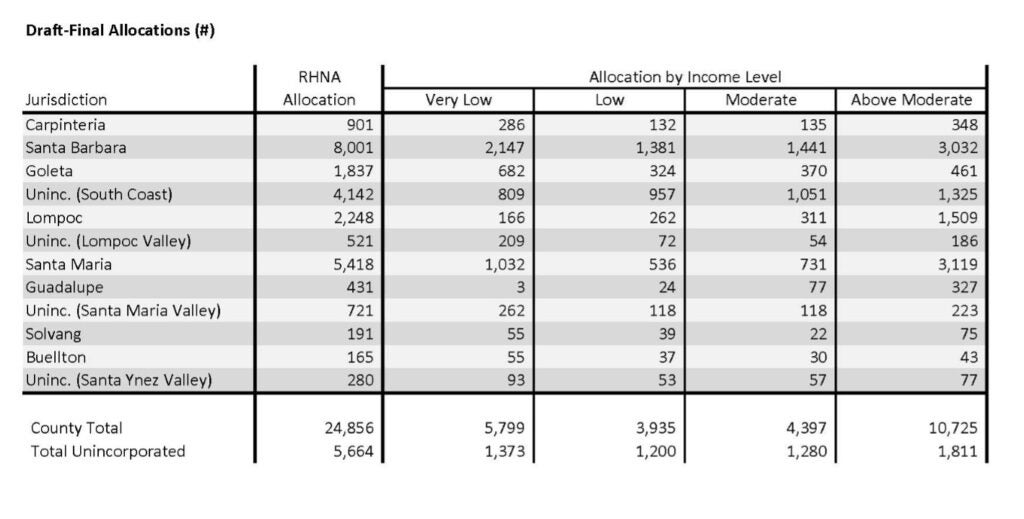Housing

Major Milestone Achieved in the Multi-Year Regional Housing Needs Allocation Process
March 22, 2021
Santa Barbara County Association of Governments Board of Directors vote 12-1 to distribute 24,856 housing units to the region’s eight cities and unincorporated areas to adequately plan to meet future housing needs.
Santa Barbara, Calif. – The Santa Barbara County Association of Governments (SBCAG) Board of Directors voted 12-1 to distribute the final 24,856 countywide regional housing needs allocation (RHNA) number to local cities and the county for their future housing production planning efforts over an eight-year period between the years of 2023 and 2031. Director Al Clark, Carpinteria City Councilmember, voted in opposition. The distribution methodology prioritizes reducing countywide jobs-housing imbalance and advances five statewide objectives, such as promoting infill development, affirmatively furthering fair housing, and seeking parity across the region as it relates to housing offered to various income-level housing needs. The board’s action allocates 60 percent of the final countywide number to South Coast where 60 percent of the region’s jobs exist. Local jurisdictions have a 45-day appeal period to appeal their own allocation, or another jurisdiction’s allocation.
“While the Regional Housing Needs Allocation process is technical, it can also be acrimonious and misunderstood. At the end of the day, our responsibility as cities and counties is to do everything we can to help housing production for people who live and work in our communities,” said SBCAG Vice-Chair Das Williams, Supervisor First District. “This is vital for our region’s prosperity, to meet climate change goals and reduce impacts of traffic congestion resulting from the imbalance between affordable housing opportunities and where jobs exist.”
The adopted allocation methodology distributes housing units through a two-step process that is representative of Santa Barbara County’s distinct subregions – North County and South Coast to allow for an intentional focus on the county’s respective, subregional jobs-housing imbalance. The first step factors existing and forecasted jobs to address the current jobs-housing imbalance while also acknowledging future conditions will change over time. The second step allocates housing units to each respective local jurisdiction giving equal weight to social equity considerations of communities experiencing overcrowding and cost burden. Cost burden is defined by households expending more than 30 percent of income on housing and overcrowding is defined by households with more than one person per room, including a living room. The housing unit number assigned to each jurisdiction is then respectively balanced per income level type i.e., very low to above moderate in comparison to the region to ensure there is an equity of income levels represented among all the local jurisdictions in Santa Barbara County.
The table below provides allocations shared with cities and the county following the SBCAG Board action based on the final housing need determination and methodology.

Local jurisdictions will have 45-day appeal period to appeal their own allocation, or another jurisdiction’s allocation. The close of the appeals period is expected to be May 3, 2021. At the close of the appeals period, SBCAG will notify all local agencies of any appeals received. If no appeals are received SBCAG will issue final RHNA allocations. The final plan will be considered by the SBCAG Board during the August 2021 meeting.
What is RHNA?
RHNA is the State’s fair share housing law. It requires local governments to plan for a minimum number of housing units across four income groups. The State’s Housing and Community Development department is responsible for determining each region’s need. Regional agencies, such as SBCAG, are responsible for developing a methodology to allocate the housing units to local governments. Finally, each local government, by updating its Housing Element, accommodates its share of housing need. This is the 6th cycle which covers the 2023-2031 period. More information can be found on HCD’s Regional Housing Needs Allocation and Housing Elements’ webpage.


 March 18 Regional Housing Needs Allocation SBCAG Board Staff Report
March 18 Regional Housing Needs Allocation SBCAG Board Staff Report
